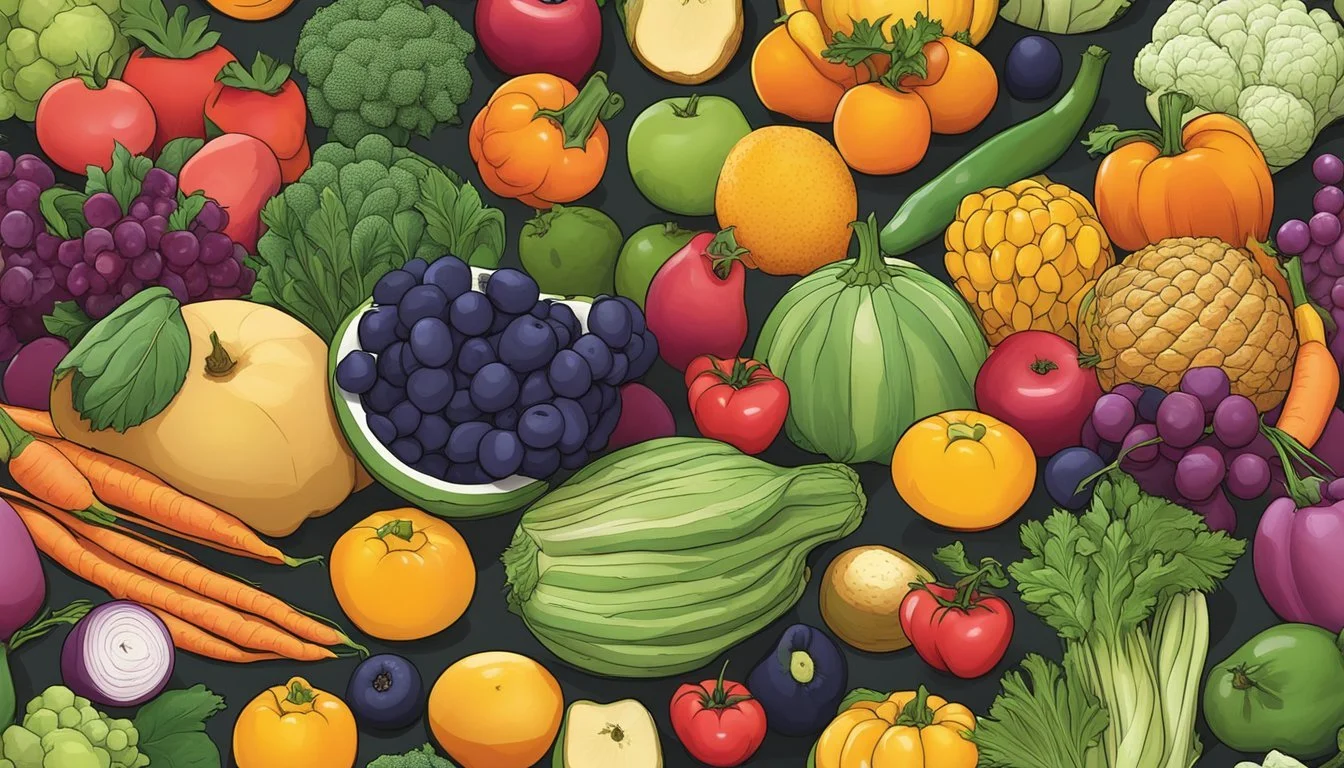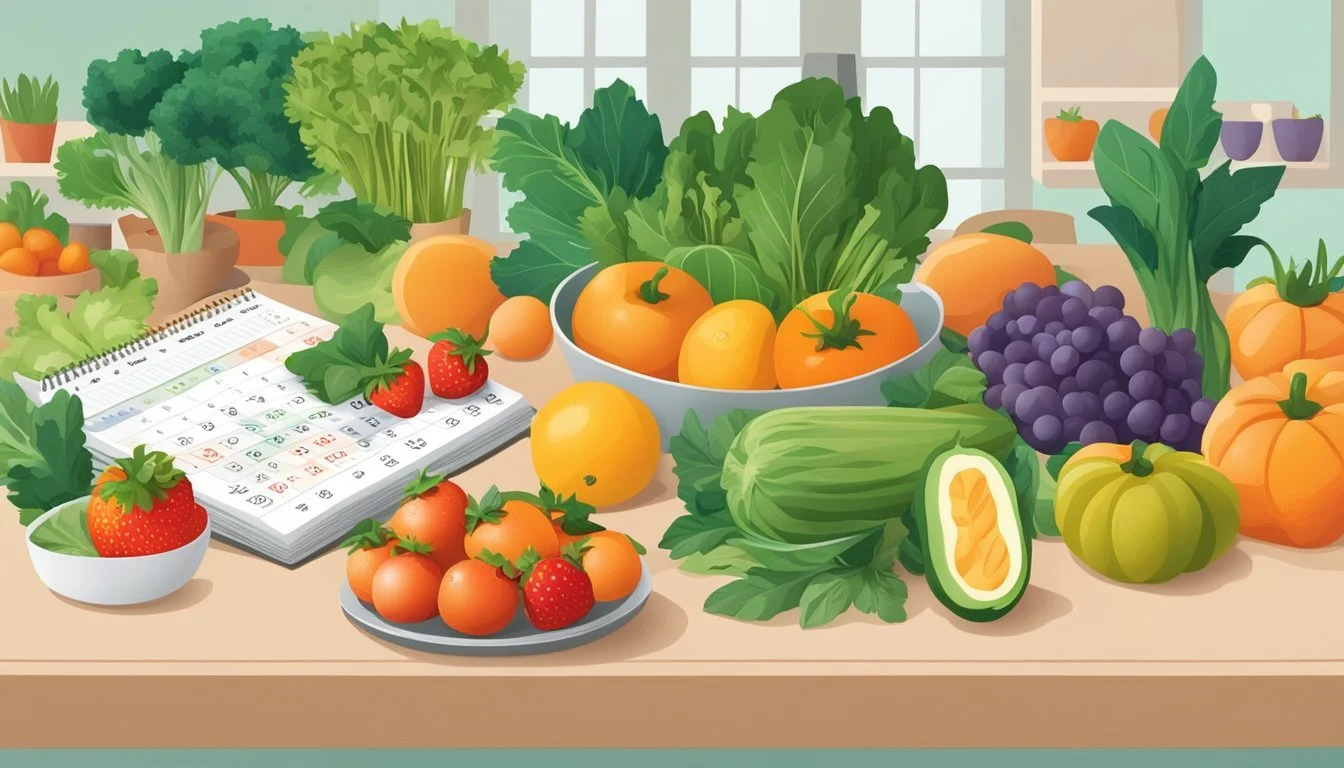Arizona Seasonal Fruit & Vegetables in February
Your Fresh Produce Guide
This Article is Part of our Arizona Seasonal Fruit & Veg Calendar
February in Arizona marks a time when seasonal crops offer unique local flavors that cater to the tastes of the region and the availability granted by its diverse climate. In the cool winter month, Arizona's agriculture boasts a variety of fruits and vegetables that are at their peak, ensuring the freshest quality and flavor for consumers. This brief seasonal guide indicates a wealth of produce that residents and visitors can enjoy, highlighting the local harvest that can be found at farmers' markets and grocery stores throughout the state.
The citrus fruits, leafy greens, and cruciferous vegetables of Arizona thrive during February. The citrus harvest includes oranges, lemons, and grapefruit, each bursting with zesty flavor and high in vitamin C, an essential nutrient during the colder months. Salad enthusiasts can rejoice in the crisp freshness of greens like spinach and lettuces, which are staples of Arizona's February produce.
Root vegetables also make a significant appearance as they continue to grow well into the winter. Beets (how long do beets last?), carrots, and radishes offer earthy flavors and substantial textures, perfect for hearty winter dishes. These crops reflect Arizona's agricultural proficiency and the state's ability to produce a rich variety of fresh produce throughout the seasons.
The Climate and Soil of Arizona
Arizona's widespread appeal to growers owes much to its unique climate and soil composition suitable for a variety of crops. The state's soil and climatic conditions set the stage for year-long planting and harvesting.
Understanding the Desert Environment
Arizona is characterized by its desert environment, featuring sandy and loamy soil that drains well. The soil here is often alkaline due to low rainfall. To grow a successful garden, one must amend the soil to improve fertility and water retention. Gardeners and farmers often add organic matter to help the soil conserve moisture, which is crucial in a desert landscape where water is a precious resource.
The Impact of Hot Summers and Mild Winters
Hot summers in Arizona lead to high temperatures that can promote the ripening of certain fruits and vegetables. However, these conditions require careful water management to prevent stress on plants. Mild winters allow for the growth of cool-weather crops without the threat of a hard freeze, although occasional light frosts can occur. The seasonal shifts in temperature influence not only the growing cycles but also the scheduling of planting and harvesting.
Seasonal Growth Patterns
In Arizona, February marks a period of transition in agricultural cycles, bridging the winter harvest with the anticipation of spring crops. Both the tail end of winter and the cusp of spring offer unique contributions to the region's produce bounty.
Winter Harvest
In the midst of winter, Arizona's agricultural landscape continues to yield an array of produce. Vegetables such as arugula (how long does arugula last?) and beets remain resilient against cooler temperatures. Meanwhile, farmers harvest citrus fruits, a staple of Arizona's winter crop, delivering freshly picked oranges, grapefruits, and lemons. The key to success in winter harvest lies in the ability to manage and select crops that can thrive in the chillier weather typical of the season.
Citrus Fruits: Oranges, Grapefruits, Lemons
Leafy Greens: Arugula
Root Vegetables: Beets
Upcoming Spring Season
As winter wanes, Arizona’s growers prepare for the upcoming spring season. Planting begins for various herbs and warm-season vegetables like tomatoes and peppers, which will mature as temperatures rise. February is a crucial month for sowing seeds and tending young plants that will flourish in the spring months.
Herbs: Planting begins
Warm-season Vegetables: Tomatoes, Peppers
Preparation: Sowing seeds, Agricultural planning
February's Availability List
In February, Arizona's fields and orchards yield a fresh variety of fruits and vegetables that are perfect for seasonal meals and recipes. Consumers can enjoy produce at its peak taste and nutritional value during this time.
Vegetables Ready for Harvest
In February, a range of vegetables is ready to be harvested in Arizona. Consumers will find that broccoli (how long does broccoli last?) and cauliflower remain crisp and fresh, being winter favorites. Leafy greens, such as spinach and lettuce, continue to thrive in the cool weather. Root vegetables like carrots and beetroots are also available, ideal for warm, hearty dishes.
Broccoli
Cauliflower (how long does cauliflower last?)
Carrots
Spinach
Beetroots
Fruits in Season in February
The cool month of February brings with it a selection of citrus fruits, which are a characteristic produce of Arizona. Grapefruits and lemons are especially abundant, offering a burst of vitamin C. Oranges, along with sweet tangelos and blood oranges, are also at their juicy best.
Grapefruits
Lemons
Oranges
Tangelos
Blood Oranges
Sustainable Practices in Arizona Farming
Arizona has a significant role in the agricultural sector, especially with its production of vegetables and fruits. As a state faced with drought challenges, Arizona's agricultural community places emphasis on sustainable practices to preserve vital resources.
Water Conservation Techniques
Water is a critical resource in the arid climate of Arizona. Farmers employ various water-saving methods to ensure sustainability:
Drip Irrigation: Directs water to the root zones of plants, reducing evaporation.
Water Reclamation: Enables the reuse of water for multiple purposes.
Sustainable Agriculture
Agriculture in Arizona is moving towards more sustainable practices. It's integrating methods that support long-term ecological balance:
No-till Farming: Reduces soil erosion and water runoff, while increasing water infiltration.
Reduced Tillage: Limits soil disruption, preserving soil health and moisture.
Cover Cropping: Protects the ground, enriches the soil, and prevents weeds naturally.
Farmers also focus on crop variety to maintain soil fertility and to contribute to a diverse ecosystem. These practices are a response to both environmental necessity and the increasing demand for sustainable produce.
Impact of Sustainable Practices
The implementation of sustainable practices has measurable benefits in Arizona:
Increased use of conservation agriculture techniques among large-scale growers.
The upward trend in sustainable land-use, with significant increases in no-till and reduced tillage adoption.
By adopting these methods, Arizona's agriculture is evolving to face climate challenges and lead in sustainable farming.
Preparing and Storing Seasonal Produce
When handling seasonal produce in Arizona during February, it's crucial to focus on proper storage techniques to maintain freshness and flavor. The following advice gears towards extending the longevity of vegetables and fruits that are typically harvested during this month.
Tips for Vegetable Storage
Vegetables harvested in February, such as leafy greens, require moisture and cool temperatures to stay fresh. The consumer should:
Store leafy greens in plastic bags with a few drops of water and refrigerate.
Keep root vegetables like carrots and beets in a cool, dark place, preferably in a ventilated container.
Avoid washing vegetables until right before use to prevent premature spoiling.
Keeping Fruit Fresh
Fruits, like strawberries which are abundant in Arizona's February, need careful handling:
Store berries in a single layer on a paper towel in a covered container to reduce moisture and prevent mold growth.
Citrus fruits stay fresh longer when kept at cool room temperatures away from direct sunlight.
Refrigeration is recommended for cut or ripe fruits to slow down decay and maintain taste.
Health Benefits of Seasonal Eating
Seasonal eating refers to the practice of consuming produce that is grown and harvested at the time of year when it is naturally ripe. Integrating seasonal fruits and vegetables into one's diet provides a range of health benefits.
Nutrient Density:
Variety: Seasonal produce is fresher and tends to be more nutritious than out-of-season fruits and vegetables that may have traveled long distances.
Peak Flavor: They often contain higher levels of antioxidants and other nutrients because they are picked at their nutritional peak.
Environmental Benefits: A diet consisting of seasonal produce can also indirectly benefit health by supporting sustainable agricultural practices that maintain soil health and reduce transportation emissions.
Freshness and Taste:
Local harvests mean fruits and vegetables are fresher, tastier, and retain more nutrients compared to those stored over long periods.
Immunological Boost:
Consuming a diversity of produce as it comes into season can support the immune system. Nutrients such as vitamin C and vitamin A, found abundantly in seasonal produce, are crucial for immune function.
Local Economy Support:
Eating seasonally also often aligns with supporting local farmers and producers, fostering community health and economic stability.
Adjusting one's diet with the seasons naturally diversifies the types of produce consumed, potentially leading to a broader intake of essential nutrients. This can contribute to a well-rounded diet, better health, and more enjoyment from meals comprised of fresher, tastier ingredients.
Recipes and Cooking Ideas
Exploring the bounties of Arizona’s February harvest, one finds an array of vibrant citrus fruits and hearty vegetables to inspire a host of seasonal dishes. These ingredients can transform everyday cooking into a celebration of winter’s freshness and variety.
Winter Vegetable Dishes
Root vegetables and leafy greens thrive in Arizona's cooler February temperatures, offering a wealth of options for comforting and nutritious meals. Carrots and turnips, boasting their peak flavors, can be roasted to enhance their natural sweetness or incorporated into stews for a hearty touch.
Roasted Root Vegetables: Toss carrots and turnips with olive oil, salt, and favorite herbs. Roast until caramelized.
Hearty Vegetable Stew: Simmer chopped root vegetables with vegetable stock, garlic, and onions for a warming dish.
Citrus-Inspired Creations
Citrus fruits are a standout during February, providing fresh zesty flavors that can brighten up winter dishes. Oranges, grapefruits, lemons, and tangerines not only contribute a refreshing taste, but also offer a rich source of vitamin C.
Citrus Salad: Combine sliced oranges, grapefruits, and a drizzle of honey for a simple, revitalizing salad.
Lemon-Garlic Dressing: Emulsify fresh lemon juice with olive oil, minced garlic, salt, and pepper for a zingy salad dressing.
Gardening Tips for Local Residents
In February, Arizona's gardening enthusiasts can capitalize on the mild winter to prepare their gardens. Both vegetable gardens and fruit trees can benefit from the cooler temperature to establish themselves before the heat intensifies.
Starting a Home Vegetable Garden
For residents starting a vegetable garden, February is an ideal time to plant cool-season crops. They should focus on preparing raised garden beds, which provide excellent drainage and improve soil quality. Suggested vegetables to plant include:
Leafy greens like lettuce and spinach
Cruciferous vegetables like broccoli and cauliflower
Root vegetables such as carrots and beets
Gardeners must be mindful of pests such as aphids, which are drawn to new growth. Using physical barriers or organic pest controls can help protect these young plants.
Growing Fruit Trees in Arizona
When it comes to fruit trees, local residents have a window of opportunity in February to plant or maintain their orchards. Due care should be taken to choose varieties that are well-adapted to Arizona's regional climates. For instance:
Citrus trees thrive in the lower desert areas and can be planted now.
Apple varieties such as 'Gala' and 'Fuji' can also be planted, keeping an eye on regional suitability.
Residents should ensure proper watering schedules and be vigilant about caterpillar infestations, particularly on Texas Mountain Laurel, which often occur this time of the year. Regular pruning and the removal of affected foliage can help manage these pests.
Conclusion
The array of fruits and vegetables available in Arizona during February can enhance any diet with a combination of nutrient-rich and flavorful options. Shoppers are encouraged to seek local produce markets for the freshest picks of the season.
During this month, citrus fruits are notably ripe for the taking. Arizona's February produce includes:
Oranges: Sweet and tangy, perfect for juicing or snacking.
Grapefruits: Juicy with a blend of tart and sweet.
Tangerines: Easy to peel and great for on-the-go consumption.
For vegetables, shoppers should look out for:
Leafy greens: Such as spinach and kale, which are packed with vitamins.
Broccoli: A versatile vegetable rich in fiber and vitamins.
Cauliflower: Known for its adaptability in recipes and health benefits.
Purchasing seasonal produce supports local agriculture and tends to provide a higher nutritional value, as these foods are harvested at their peak freshness and flavor. The offerings in February also allow for a wide array of vibrant, hearty meals, side dishes, and snacks.
For individuals conscious about sustainable eating habits, incorporating these seasonal fruits and vegetables into their menu not only contributes to a more sustainable food system but can also result in economic savings. Buyers can take advantage of this season's bounty to enjoy Arizona's freshest produce and to explore a variety of taste profiles and culinary applications.








